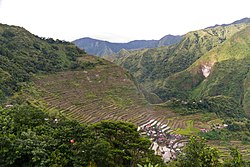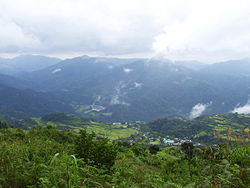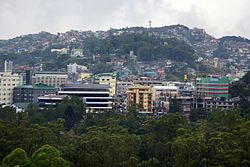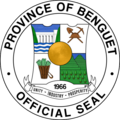Cordillera Administrative Region
Cordillera Administrative Region is an administrative region in the Philippines. It is on the island of Luzon. The regional center is Baguio.
|
CAR | |
|---|---|
|
From top, left to right: Batad Rice Terraces; Tayum Church; Lubuagan, Kalinga; Colors of StoBoSa, Hanging coffins of Sagada | |
| {{safesubst:#property:P242}} Location in the Philippines | |
| Country | |
| Island group | Luzon |
| Regional center | Baguio |
| Area | |
| • Total | 19,422.03 km2 (7,498.89 sq mi) |
| Population (2015)[1] | |
| • Total | 1,722,006 |
| • Density | 88.66251/km2 (229.63486/sq mi) |
| Time zone | UTC+8 (PST) |
| ISO 3166 code | PH-15 |
| Provinces | 6
|
| Cities | 2
|
| Municipalities | 75 |
| Barangays | 1,176 |
It was created on July 15, 1987. There are 6 provinces: Abra, Apayao, Benguet, Ifugao, Kalinga and Mountain Province.
Mount Pulag, the highest mountain in Luzon, is in the region. Rivers include the Chico River, Abulog, and Siffu River. Tourist sites include Banaue Rice Terraces, Cassamata Hill National Park, and Balbalasang-Balbalan National Park. [source?]
Cordillera Administrative Region Media
Detail of the Wall of Remembrance at the Bantayog ng mga Bayani in Quezon City, showing names from the first batch of Bantayog Honorees, including that of Macli-ing Dulag.
- Takit Bersamin.jpg
Takit Bersamin in 2024
References
- ↑
Census of Population (2015). Highlights of the Philippine Population 2015 Census of Population. PSA. Retrieved 20 June 2016.
{{cite encyclopedia}}: Cite has empty unknown parameter:|chapterurl=(help)













